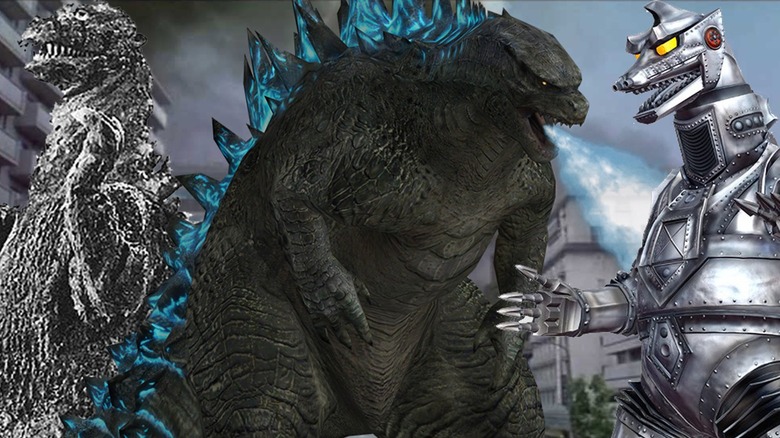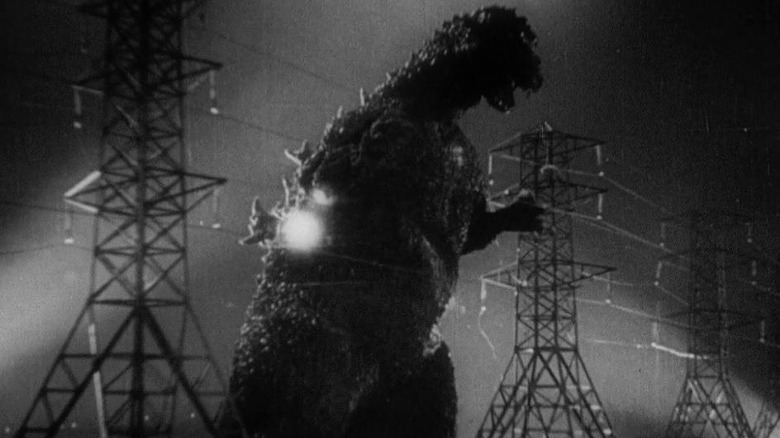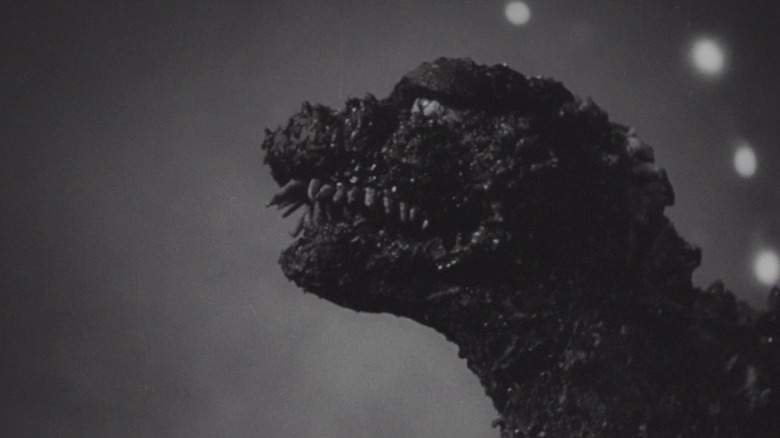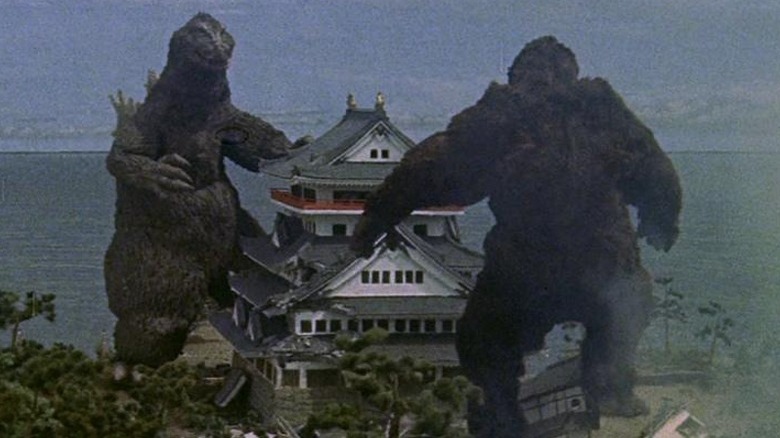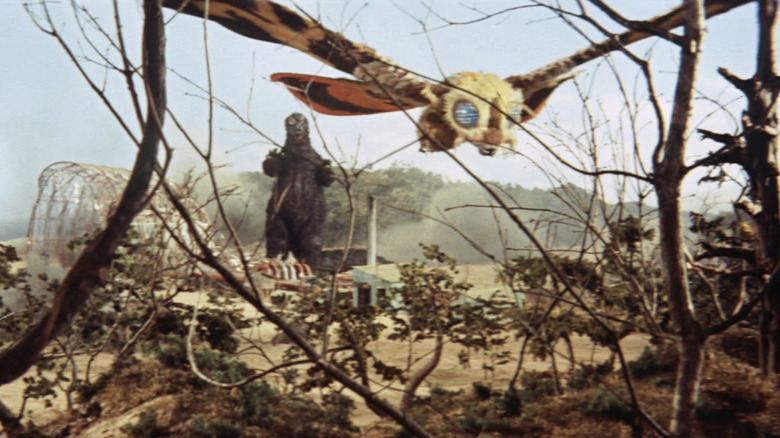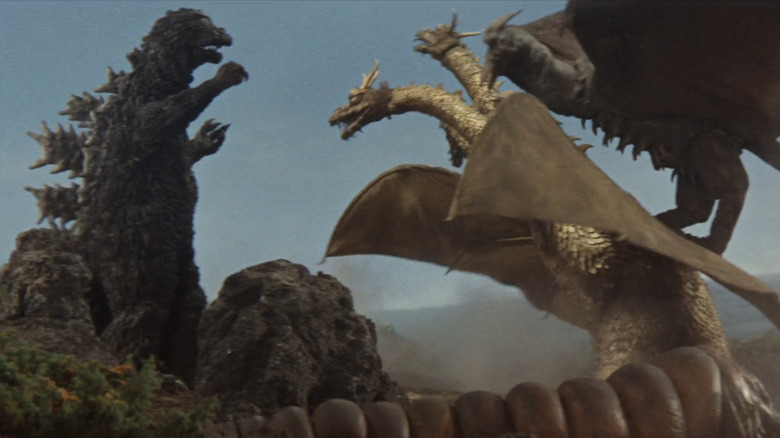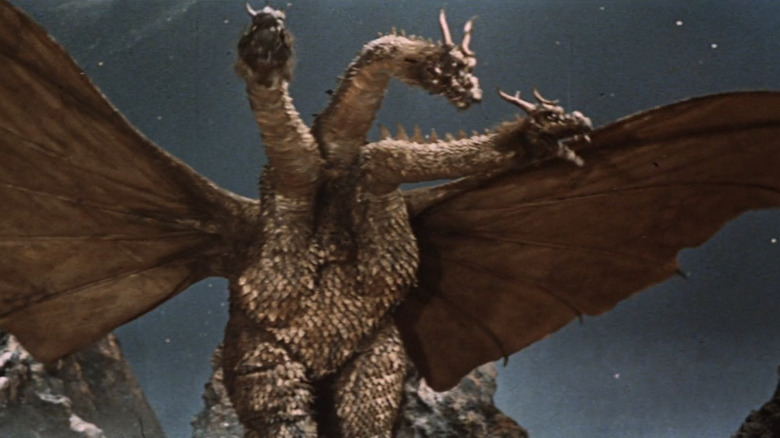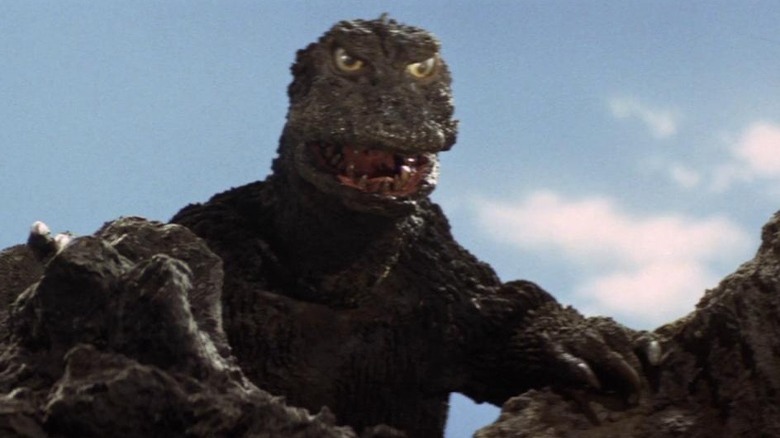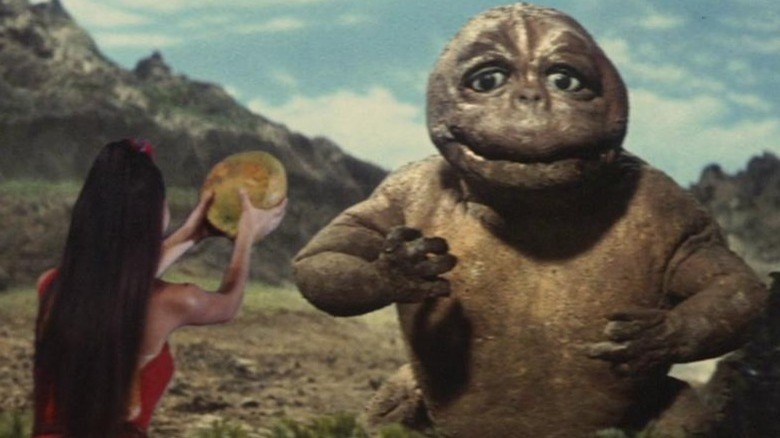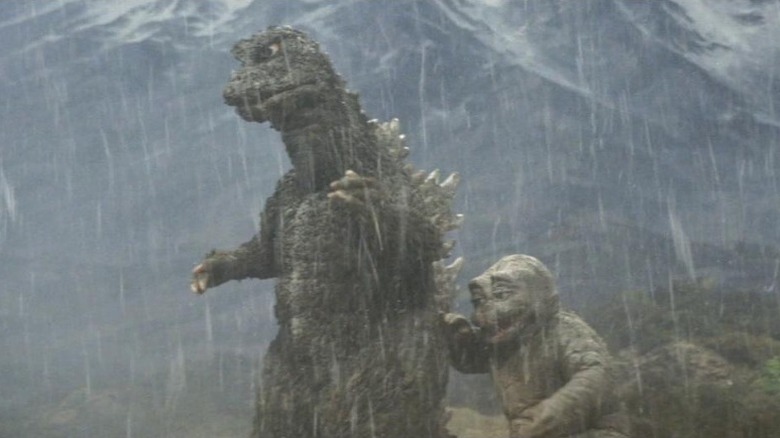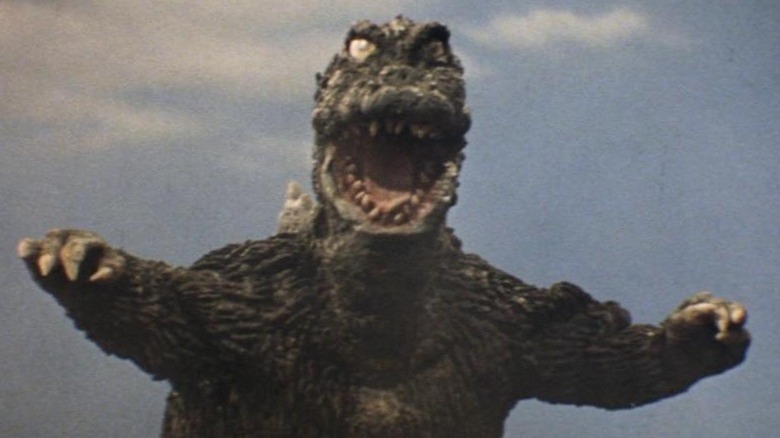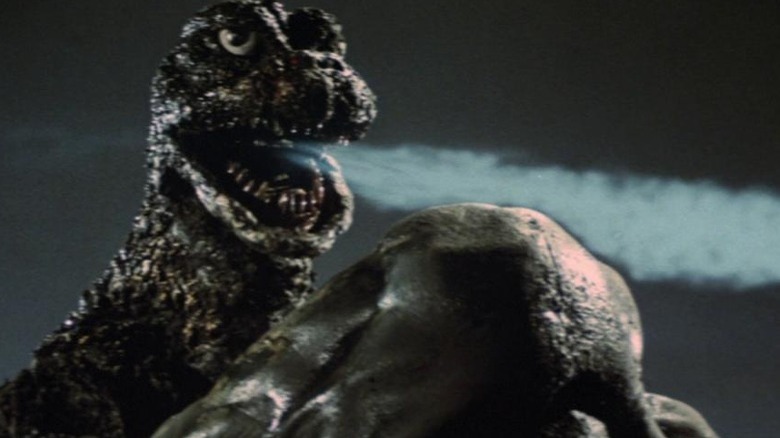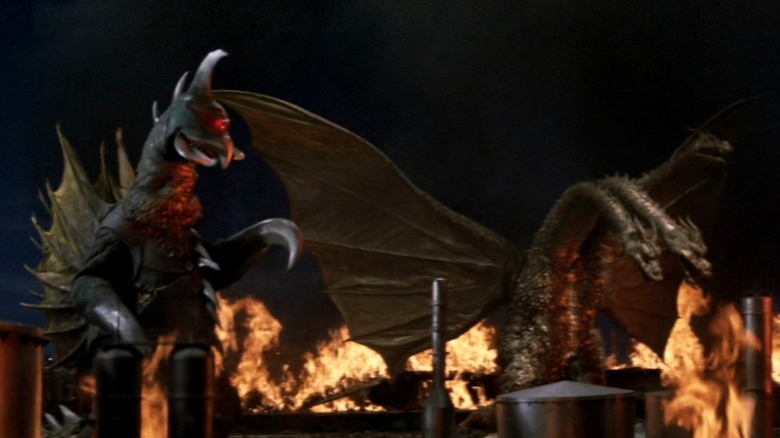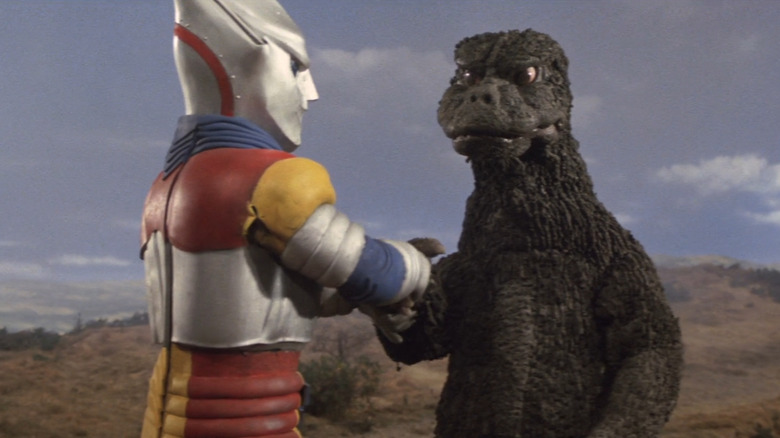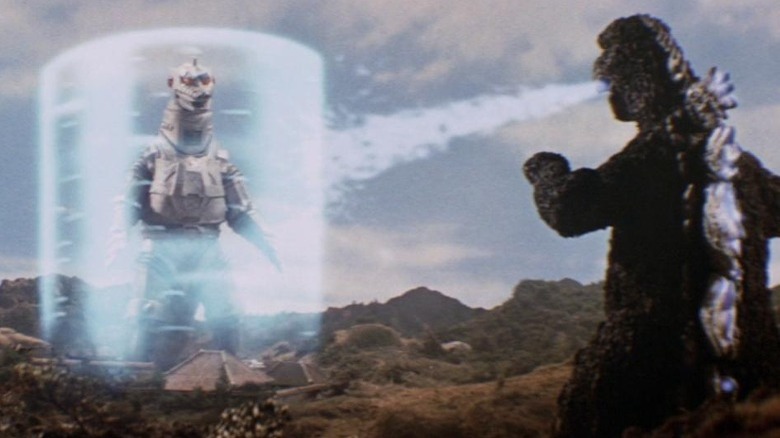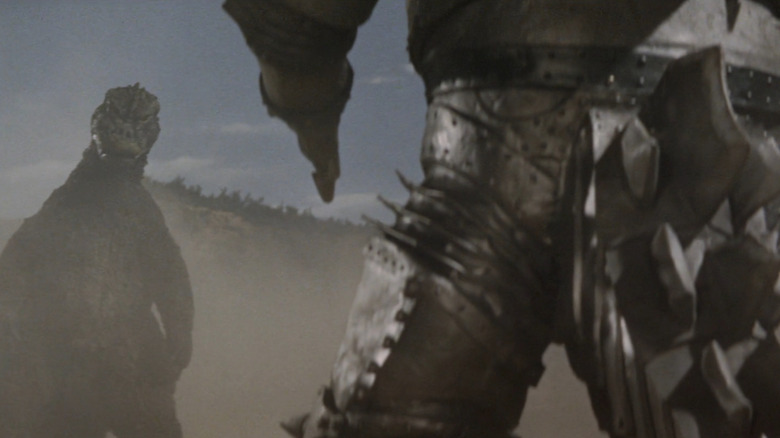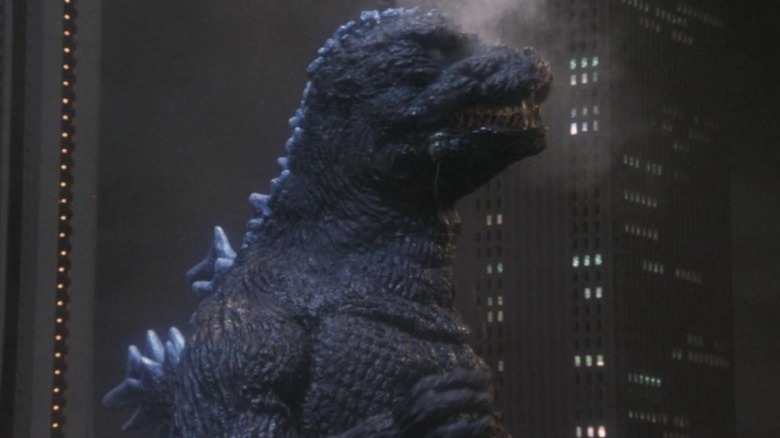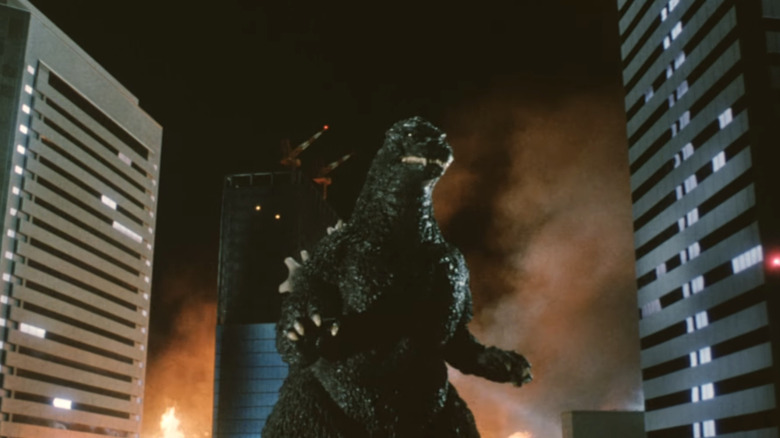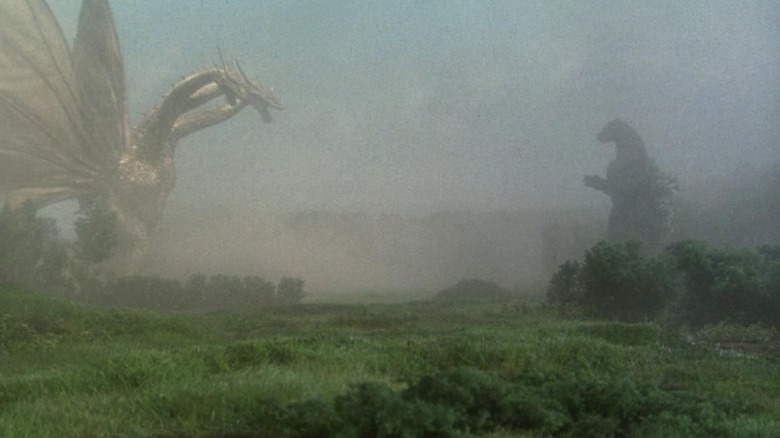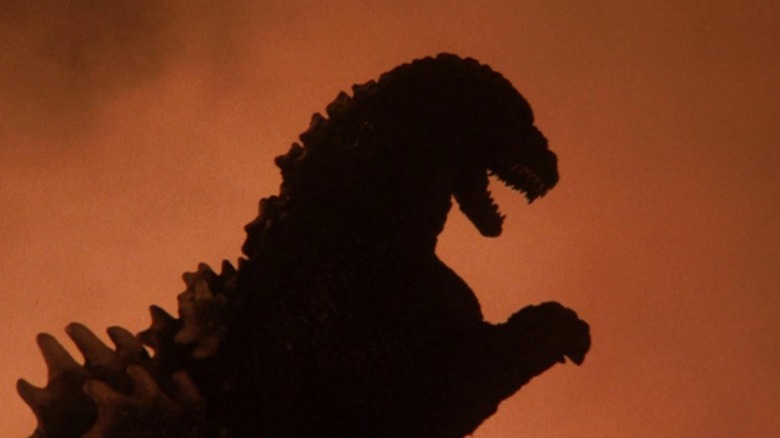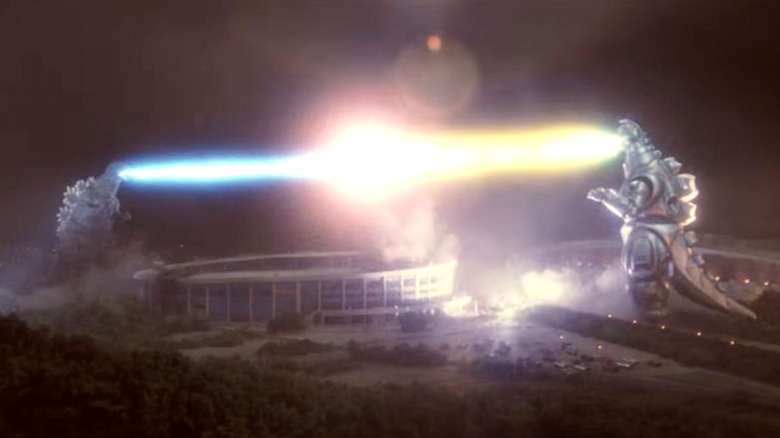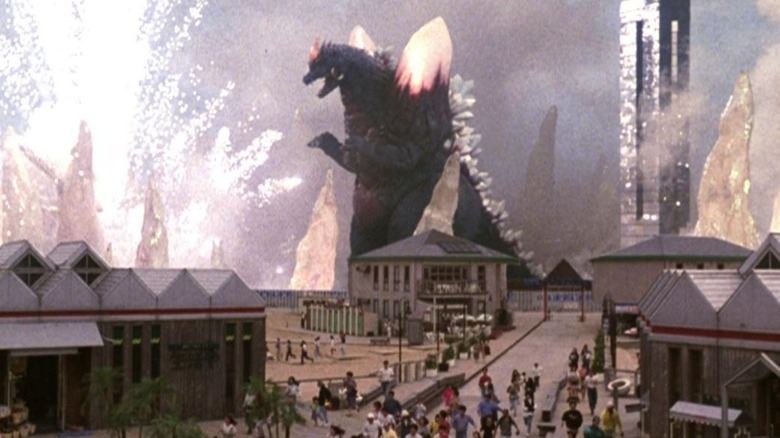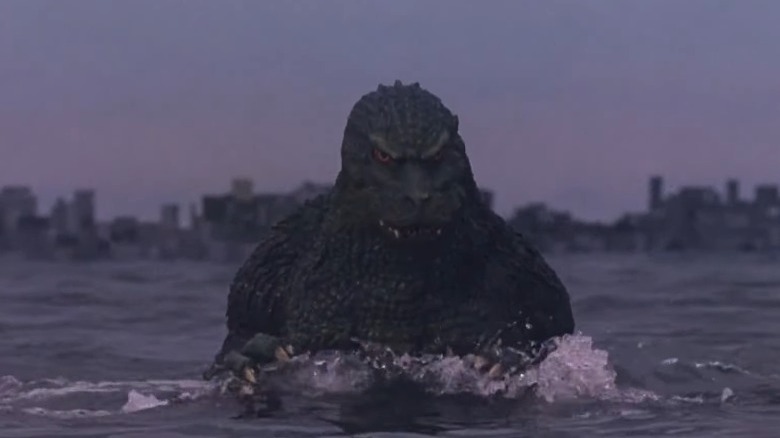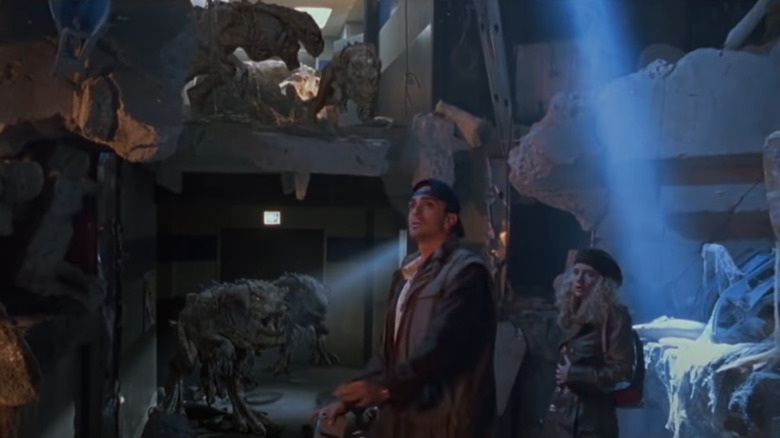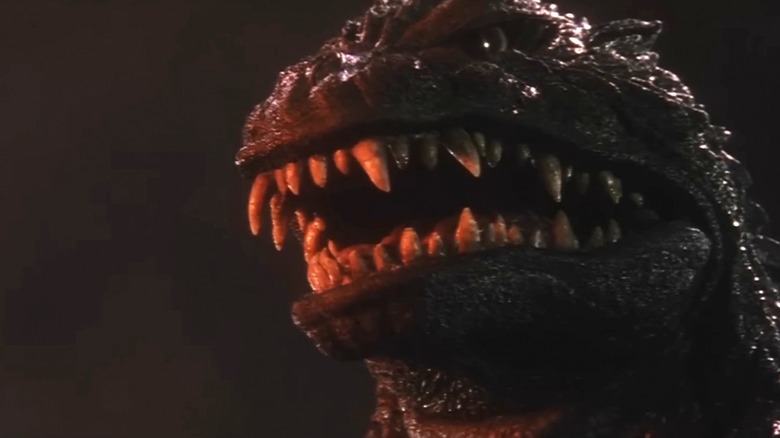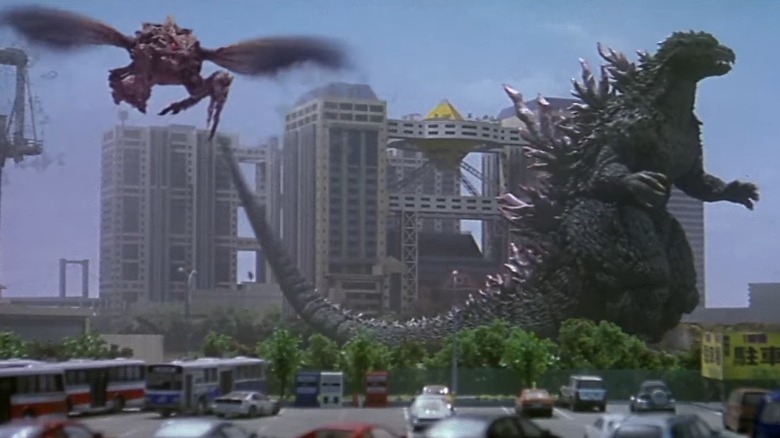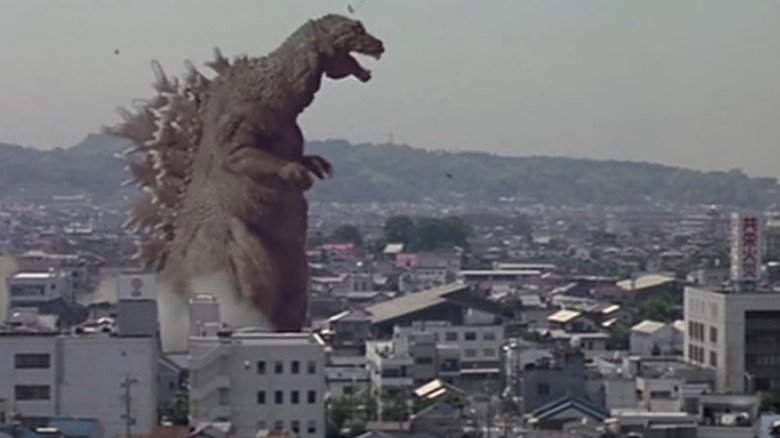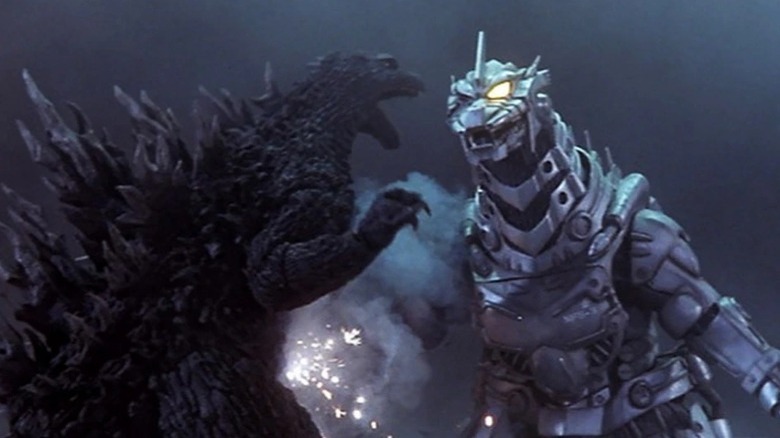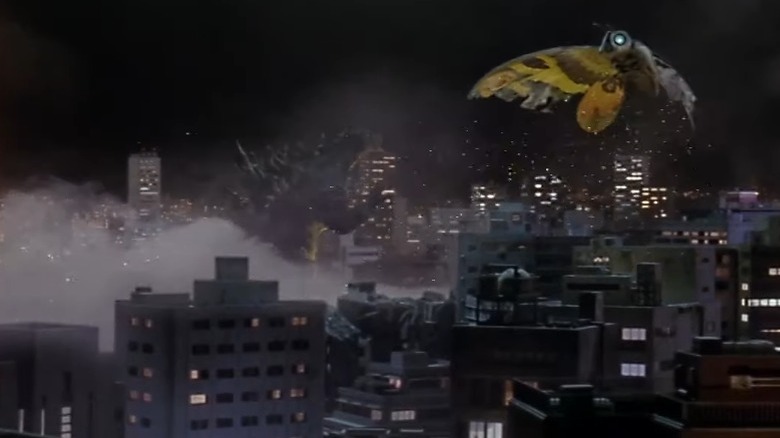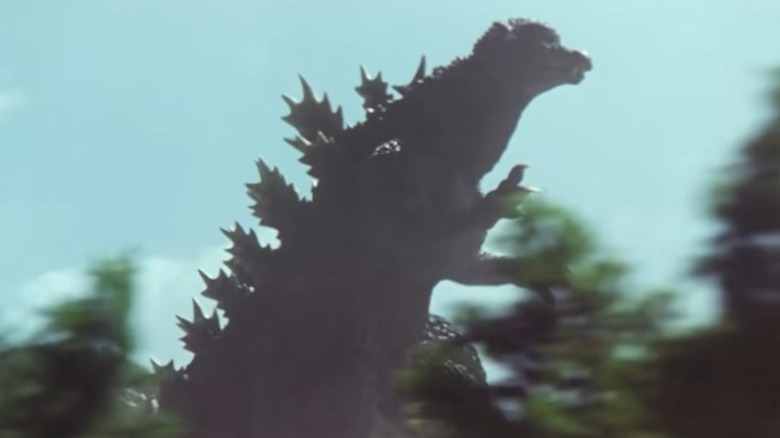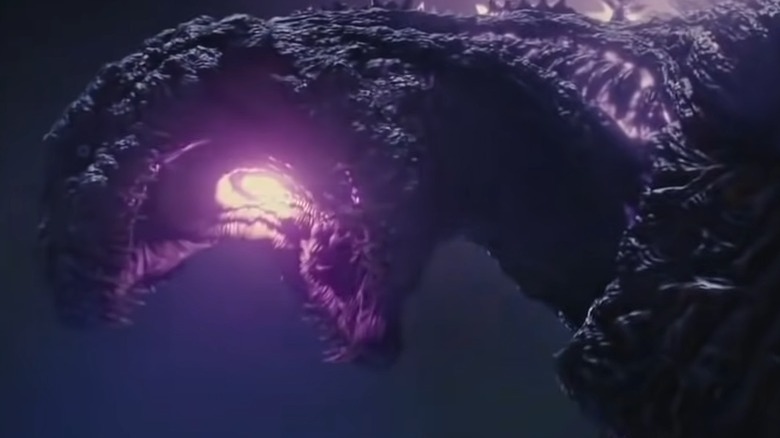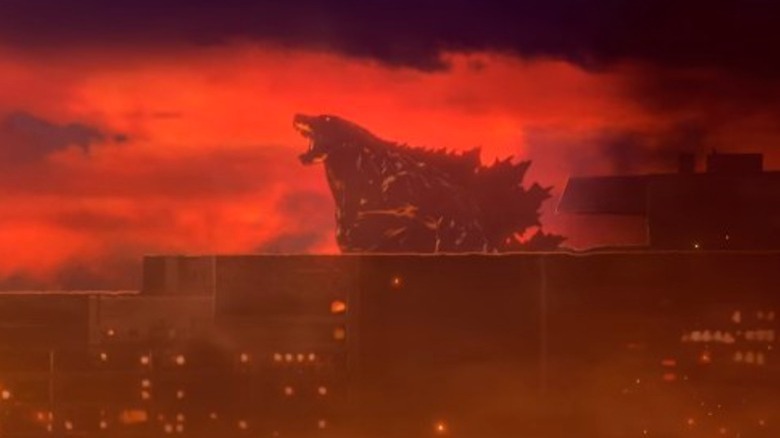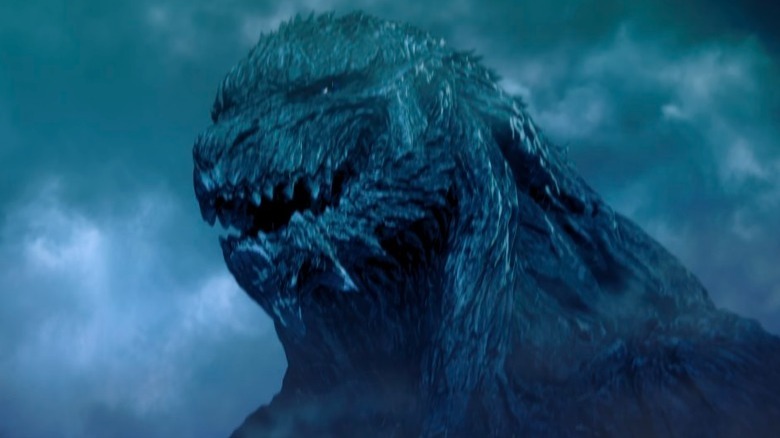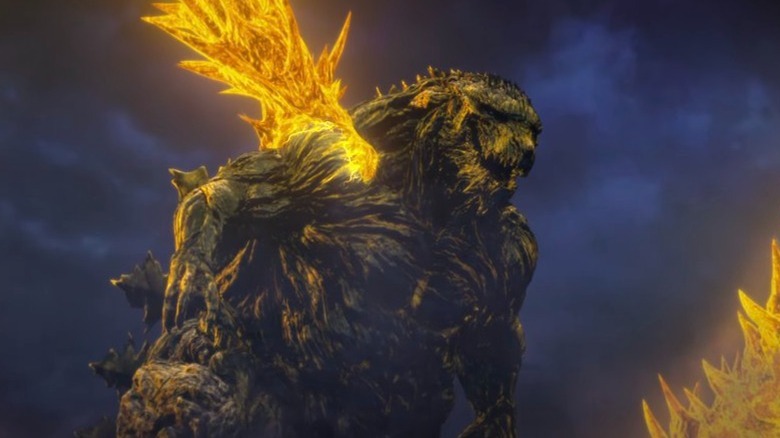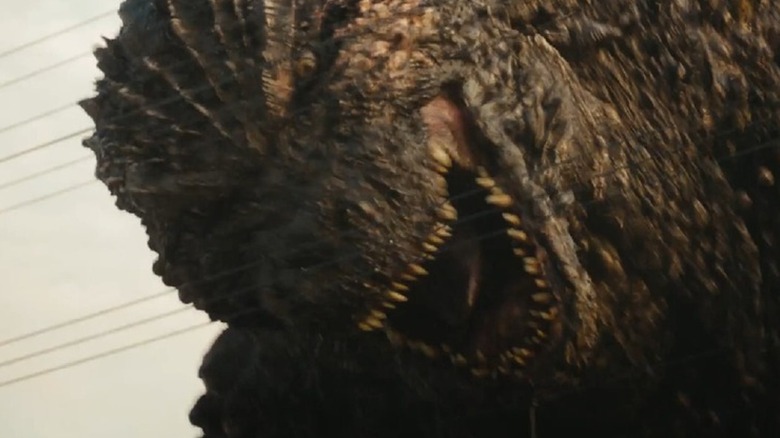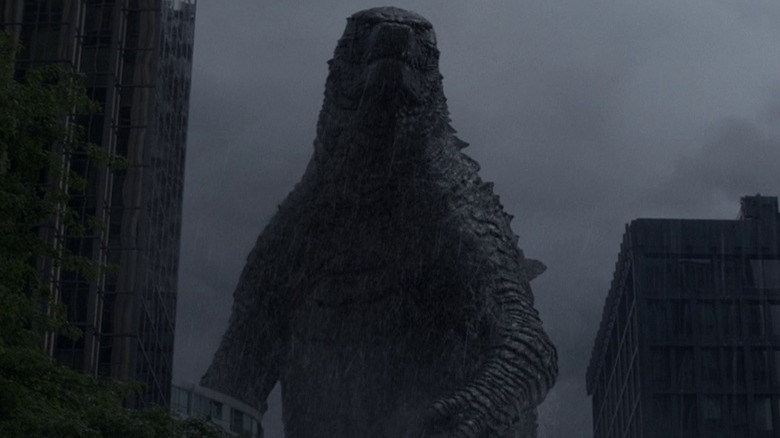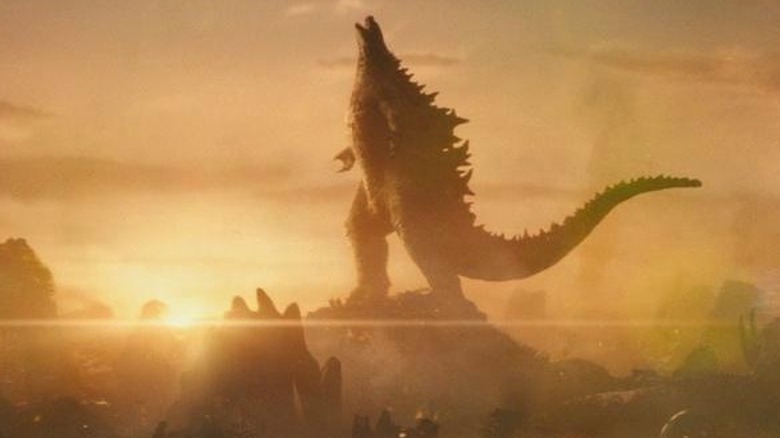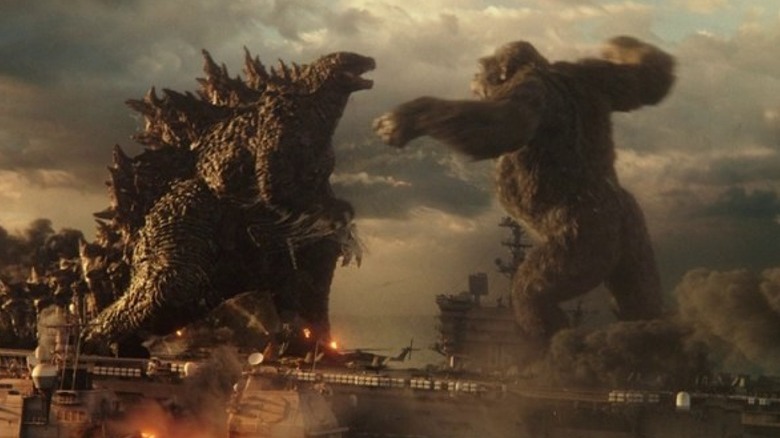The Correct Order In Which To Watch Every Godzilla Movie
Since he stomped his way through the streets of Tokyo in 1954, Godzilla has been King of the Monsters. What started as a cautionary tale about the horrors of nuclear war evolved into a national symbol of pride and a decades-long film franchise that continues to this day with feature films, comic books, video games, and more. "Godzilla" movies began affixed to the horror genre before transitioning into mindless escapist entertainment, and it's since returned to horror.
Dozens of "Godzilla" movies have been released, and more are coming out almost regularly, making it difficult to know the best order in which to watch them. Cards on the table, it's probably best to watch them in chronological order, as they tell an ongoing narrative. That said, there are four distinct eras; you can watch them separately or in the order in which they were released. This article details every movie in the franchise and the order in which you should watch them. Entries with multiple titles feature the Japanese title first, followed by the American version.
Godzilla (1954) and Godzilla, King of the Monsters! (1956)
The first "Godzilla" movie in 1954 introduced the world to the terrors of Gojira in beautiful black and white. The film launched the longest continuously running film franchise ever made, and it did so by putting a guy in a rubber suit and having him tear through intricately built miniature sets. "Godzilla" wasn't the first movie to use suitmation, but it set a standard that would influence monster movies for decades.
Ishirō Honda managed to terrorize moviegoers while remaining true to his message about the horrors of nuclear war. That's no easy task, and the director was the only person who could make it happen. Sure, you can watch it and ignore the message, but doing so eliminates the whole point of the movie. That's essentially what happened with the 1956 Americanized U.S. release, titled "Godzilla, King of the Monsters!"
If you're more into horror than campy escapism, you can watch this and skip to the 16th film in the Japanese franchise, "The Return of Godzilla." If you'd like to watch the original and then skip to the end of the century, you can seek out to "Godzilla 2000: Millennium," the 24th film overall in the franchise.
Godzilla Raids Again (1955) and Gigantis, the Fire Monster (1959)
It didn't take long for "Godzilla" to become popular, and a sequel, "Godzilla Raids Again," was released a year after the first. In the film, Japan struggles to deal with another attack by Godzilla shortly after his last rampage through Tokyo. "Godzilla Raids Again" introduced a concept that would continue throughout the franchise: Godzilla is not alone. Godzilla faces off against Anguirus, a massive Ankylosaurus able to fire off a beam of light from his mouth.
Since Godzilla had already leveled much of Tokyo, the battle for this film shifted to Osaka. Humans attempt to lure him away, but to no avail, as a prison escape results in a massive fire that draws Anguirus to the city. This leads to the first kaiju battle in the "Godzilla" franchise, and it's epic. Godzilla and Anguirus fight one another as explosions barely distract them. The city is destroyed and engulfed in flames before Godzilla comes out on top. The U.S. released a poorly Americanized version once again, this time titled "Gigantis, the Fire Monster."
King Kong vs. Godzilla (1962)
King Kong is the OG kaiju, having first appeared in 1933, but "King Kong vs. Godzilla" was only the third film to feature him in nearly 30 years. The film began development as a Kong picture, but producers ultimately added Godzilla and made movie history. The film centers around Godzilla's reawakening by American submarines while a pharmaceutical company captures Kong for a promotional venture — because that worked so well the first time.
Eventually, the humans deploy Kong against Godzilla, so they drop him on Mount Fuji so they can face off against each other. Kong and Godzilla have a massive fight, which goes back and forth for some time before they fall off a cliff together into the water below. They continue their fight underwater, and in the end, Kong resurfaces and swims home to his island, while the whereabouts of Godzilla remains a mystery, though some believe he survived.
Mothra vs. Godzilla (1964)
Mothra was first introduced in 1961's "Mothra," and the success of that film helped make "Mothra vs. Godzilla" a reality in 1964. The film sees Godzilla return once more to Japan, forcing humanity to turn to the insect god Mothra for help. Godzilla awakens and rampages through Yokkaichi and Nagoya, causing widespread destruction. While this is happening, an appeal is made to have Mothra help defend Japan, and she agrees.
Ultimately, Mothra intervenes when Godzilla nearly destroys one of her eggs. The two fight, and Mothra takes the lead but ultimately succumbs to Godzilla's atomic breath. With her dying strength, Mothra saves her egg and dies beside it. The egg hatches, revealing twin larvae, who attack Godzilla and engulf him in silk, sending him to the bottom of the sea. The story ends on a hopeful note, as humanity promises to do better in keeping the world safe from nuclear activity.
Ghidorah, the Three-Headed Monster (1964)
Godzilla has an impressive rogues gallery, but all pale in comparison to Ghidorah. The alien three-headed dragon was first introduced in "Ghidorah, the Three-Headed Monster," and he quickly establishes himself as a powerful enemy. Humanity is warned of King Ghidorah by a Venusian being, who tells them the only hope of stopping him lies with Godzilla, Mothra, and Rodan. As for Rodan's origins, the creature was first introduced in his eponymous 1956 film, which was retitled in the U.S. as "Rodan! The Flying Monster!"
Ghidorah arrives and attacks Matsumoto, striking fear into all of humanity. Mothra then attempts to get Godzilla and Rodan to band together and fight the threat, but they decline. When they see Mothra attempt to take down Ghidorah on her own, they rush to her aid, resulting in a momentous battle involving former enemies-turned-allies against a literal space dragon. In the end, the Earth-based kaiju win, sending Ghidorah back into space.
Invasion of Astro-Monster (1965) and Monster Zero (1970)
A year after King Ghidorah devastated Japanese cities, aliens come to Earth, pleading for humanity to lend them Rhodan and Godzilla, and promise to cure all disease. They hope to get the two Earth-based Kaiju to fight Ghidorah on their world, but it's all a ruse, and instead of fighting on Ghidorah far from Earth, every monster is unleashed on Earth. The film repeats its predecessor's success by banking on King Ghidorah's gravitas in another all-out battle.
The Xiliens, as they're called in the film, intend to capture Earth after they take control of the kaiju. They fail, and the Xiliens are killed, but the monsters awaken and fight one another. King Ghidorah flies into space when the battle ends, leaving the fate of Godzilla and Rhodan up in the air when the movie ends.
This wasn't the first campy "Godzilla" film, but it perfected the aesthetic, setting a tone that would continue for years. The film was released five years later in the U.S. as "Monster Zero."
Ebirah, Horror of the Deep (1966) and Godzilla versus the Sea Monster (1968)
Sometimes, Godzilla is a monster wreaking havoc upon cities; others, he's a weapon. This movie uses him as the latter, as he's awakened purposefully to fight a terrorist organization called the Red Bamboo and the creature they control, a lobster-like monster called Ebirah. The two fight, but Ebirah escapes, leaving Godzilla time to destroy the Red Bamboo and a giant condor they control with his atomic breath.
Eventually, Godzilla faces off against Ebirah again, defeating it by tearing off its claws. Mothra awakens in her winged state and saves the innocent people on the island, but not before Godzilla challenges her over some old beef. Mothra manages to fend Godzilla off and save the people of her island before a nuclear bomb detonates, destroying it.
This was the first film to feature Godzilla on a Pacific island (outside Japan), offering a new take on an oft-repeated format. The American version of the film is titled "Godzilla versus the Sea Monster."
Son of Godzilla (1967)
King Kong had a movie made about his kid, so why not Godzilla? "Son of Godzilla" was released 34 years after "Son of Kong," and it's equally unusual. The film is set on Sollgel Island, where an experiment to control the weather is underway. The island is home to giant mantis creatures, which are irradiated and mutated into kaiju called Kamacuras. They gather on a mountain and break the shell of a large egg, revealing a baby Godzilla named Minilla.
Godzilla then makes his presence known as a gigantic spider called Kumonga awakens. Minilla eats some dead Kamacuras, and Godzilla and son work together to defeat Kumonga with the combined might of their atomic breath attacks. The scientists use their weather manipulation device to cover the island in snow. This forces both Godzilla and Minilla to hibernate, saving the world from a new rampage ... for a while.
Destroy All Monsters (1968)
"Destroy All Monsters" ups the game from its predecessors by featuring a plethora of monsters. All told, there are 11 kaiju in the film, and Godzilla is at the center. He's joined by his son, Minilla, as well as Mothra, Rodan, Anguirus, King Ghidorah, and others in a world where global peace has been achieved. Kaiju have been contained in an area called Monsterland and aren't usually a threat. Unfortunately, aliens called Kilaaks take control of the monsters and unleash them on various cities.
Widespread destruction sees the kaiju devastate several areas before the Kilaaks' control is thwarted. When this happens, King Ghidorah challenges the other monsters to an all-out battle to see who comes out on top. It takes the combined might of all Earth's monsters to take down King Ghodirah, forcing the aliens to unleash a Fire Dragon. Godzilla lets the aliens know what he thinks of them, and soon after, the kaiju return to Monster Island.
All Monsters Attack (1969)
In "All Monsters Attack," Godzilla's son, Minilla, finds himself bullied by Gabara, an amphibious kaiju. The film's structure differs from its predecessors, as much of it takes place in the dreams of a young boy named Ichiro Miki. He's bullied at school and uses his dreams as a form of escape, often finding himself on Monster Island. He meets Minilla and learns that even monsters have to deal with bullies every now and again.
He also dreams of Godzilla fighting Ebirah, a giant condor, and Kumonga — monsters he fought in previous films. He also dreams of Godzilla teaching Minilla how to fight, and the kid beats his bully! Ichiro learns from his dreams and understands how to face his fears and fight back, making the film an interesting sort of fantasy akin to "The Neverending Story" and other similar films.
Godzilla vs. Hedorah (1971) and Godzilla vs. the Smog Monster (1972)
Godzilla is a terror unleashed upon the world by man's use of nuclear weapons, and he was introduced with an anti-nuclear war message. "Godzilla vs. Hedorah" adds a new message by introducing Godzilla's antagonist, Hedorah, a kaiju that arose from pollution. The message of "Godzilla vs. Hedorah" is decidedly more environmental than nuclear, and it's effective. In the film, Hedorah is, at first, a microscopic alien lifeform that feeds off Earth's pollution. Scientists are studying Hedorah, but they quickly lose control.
Since pollution isn't hard to find, it doesn't take long for Hedorah to grow into a massive world-threatening kaiju. Hedorah lays waste via poisonous emissions, and Godzilla has trouble stopping him. Hedorah nearly kills Godzilla by attempting to drown him in a toxic sludge. With humanity's help, Godzilla manages to defeat his nemesis by dehydrating him. Once the job is done, Godzilla returns to the sea, leaving humanity to clean up the mess. The film was dubbed and re-edited for an American release titled "Godzilla vs. the Smog Monster."
Godzilla vs. Gigan (1972) and Godzilla on Monster Island (1977)
In "Godzilla vs. Gigan," giant cockroach aliens from a dying world attempt to colonize Earth. They take the form of dead people and set to work crafting a plan that hinges on using Gigan and King Ghidorah to wipe out all of humanity. Gigan made its first appearance in this film and resembles a claw-handed cyborg reptile from outer space. After their plan is discovered, a signal draws Godzilla and Anguirus to Tokyo, intent on aiding humanity. Ultimately, Godzilla manages to work with Anguirus to defeat Gigan and King Ghidorah before returning to Monster Island at the end of the film. The aliens are all killed, and everything works out well for the monsters and humanity.
This was the final film in which Haruo Nakajima portrayed Godzilla, having done so since the very beginning. Nakajima's retirement meant that others could perform as the infamous kaiju, though it was truly the end of an era. The Toho dub was released in the U.S., retitled "Godzilla on Monster Island."
Godzilla vs. Megalon (1973)
"Godzilla vs. Megalon" introduces several new kaiju to the franchise, including the titular Megalon — an insectoid kaiju who guards the underground kingdom of Seatopia. Repeated nuclear tests draw Megalon to the surface, where he attacks Tokyo alongside Jet Jaguar. Eventually, the Seatopians lose control, and Jet Jaguar increases in size to kaiju proportions. He then turns against Megalon, joining forces with Godzilla shortly after Gigan finds its way to the fight, and it's an all-out brouhaha. Godzilla and Jet Jaguar manage to fend off the other kaiju by working together, and it's a long and brutal battle. In the end, Godzilla and Jet Jaguar shake hands and go their separate ways.
This was the only film to feature Jet Jaguar and Megalon despite the latter being a fan-favorite kaiju. You can find them both in plenty of comics, manga, TV series, and video games, but for some reason, they only made this one film appearance before calling it quits.
Godzilla vs. Mechagodzilla (1974) and Godzilla vs. Cosmic Monster (1977)
Of all Godzilla's enemies, the one who keeps coming back, time and time again, is Mechagodzilla. The mechanical kaiju first appeared in "Godzilla vs. Mechagodzilla" in 1974 and remains a popular character decades later. The film also introduces King Caesar, a stone lion kaiju, though he's not as popular. In the movie, Godzilla appears and defeats Anguirus, which is odd, as they'd long since put their differences aside and become friends. The truth soon emerges: Tt's not Godzilla. An alien invasion has brought a mechanized Godzilla to Earth, and only the real Godzilla can take it down. The epic fight sees Godzilla go up against Mechagodzilla and a new host of weapons and tactics.
This is the first time Godzilla fights an enemy capable of firing different types of ordinance who also flies and can match his strength. Add a personal force field, and Godzilla struggles to defeat his foe. Godzilla manages to win by tearing off Mechagodzilla's head. In the U.S. and U.K., the re-edited English release was retitled "Godzilla vs. Cosmic Monster."
Terror of Mechagodzilla (1975)
Mechagodzilla proved its worth in "Godzilla vs. Mechagodzilla," so Toho was quick to capitalize on that by pitting it against Godzilla in "Terror of Mechagodzilla." The film introduces Titanosaurus, a kaiju controlled by a mad scientist who uses him to guard Mechagodzilla's remains. Dr. Mafune (Akihiko Hirata) rebuilds Mechagodzilla as Mechagodzilla 2 and sets his sights on the rest of humanity. Godzilla gets involved, and before long, it's Godzilla vs. Mechagodzilla 2 and Titanosaurus. The fight is even more brutal than their last, but in the end, Godzilla reigns supreme. Titanosaurus gets blasted with Godzilla's atomic blast and falls into the ocean.
Titanosaurus hasn't appeared in any "Godzilla" movies since 1975. This film also marks the end of the Shōwa era, as Toho opted to reboot the franchise with its next entry nearly a decade later. This would be the last overly campy "Godzilla" film ... at least for a while.
The Return of Godzilla (1984) and Godzilla 1985 (1985)
Toho rebooted the franchise in what is called the Heisei era, opting to return Godzilla to his roots. He'd transitioned through the Shōwa era into an anti-hero, but Godzilla's roots are in horror, and that's where he returned. "The Return of Godzilla" takes place after the first film and ignores every movie that follows. This resets the entire franchise, so you could watch "Godzilla" and skip to "The Return of Godzilla" if campy escapism isn't your thing.
The film is set thirty years after the events of the first film. Godzilla emerges from the sea following a series of volcanic eruptions. He heads straight for Japan and does what he does best: He destroys everything. Even the Super X, an armored flying fortress, fails to stop his rampage. Only by tricking Godzilla's homing instinct is the kaiju rerouted to a nearby volcano, where he's buried inside after a massive explosion. The film was re-edited the following year for American audiences as "Godzilla 1985."
Godzilla vs. Biollante (1989)
"Godzilla vs. Biollante" takes place after "The Return of Godzilla." It's the 17th film in the franchise but only recognizes the original and "Return of Godzilla." The film establishes a common trope of the Heisei era by introducing an adversary that metamorphosizes into stronger versions of itself. In this film, it's Biollante, a genetically modified human-plant-Godzilla hybrid. It was created by splicing the DNA of Godzilla's cells and a rose that was made by splicing the DNA of a scientist's (Kōji Takahashi) dead daughter (Yasuko Sawaguchi).
Biollante is the first plant-based kaiju to fight Godzilla, and it's nasty. Godzilla is freed via an explosive charge, and the only thing on his mind is getting radiation to recover his energy. He battles Biollante and defeats it temporarily. Biollante transforms into a more powerful version of itself, and they fight once more. Godzilla defeats Biollante by firing his atomic breath into its open maw and collapses from the effort.
Godzilla vs. King Ghidorah (1991)
King Ghidorah was always a fan-favorite kaiju, so it didn't take Toho long to bring him back into the rebooted franchise. In "Godzilla vs. King Ghidorah," time travelers from the 23rd century who call themselves the Futurians arrive in the present to convince the people of Japan to go further back in time to prevent Godzilla's transformation. The plan involves traveling to 1944 to prevent the mutation of a dinosaur on Lagos Island, which becomes Godzilla.
In reality, their goal is to create a new kaiju they can control, and you can guess where this is going. King Ghidorah is created from the same radiation that created Godzilla in 1954, and the Futurians initially use him to try and subjugate Japan. It doesn't work, and Godzilla is still created via the radiation of a nuclear sub in 1970, so he makes his presence known in the present (1992) and takes on King Ghidorah and then Mecha-King Ghidorah, both of whom are defeated.
Godzilla vs. Mothra (1992) and Godzilla and Mothra: The Battle for Earth (1992)
After a meteorite slams into Earth, a chain reaction results in Mothra's egg appearing on Infant Island. This also awoke Battra, the Black Mothra, Mothra's sworn enemy. After Battra destroys large swathes of Japan, it disappears, and around this time, Godzilla appears and endangers Mothra's egg. She awakens to defend her spawn and fights Godzilla in an epic battle interrupted by the reappearance of Battra. There's some back and forth as the kaiju battle one another, alternating between opponents.
While Battra and Mothra are mortal enemies, they both realize that Godzilla is the bigger threat to Earth, so they join forces to fight him. In their final forms, they manage to capture Godzilla and carry him over the ocean, but Godzilla clamps down on Battra's neck, firing his atomic breath into the wound, killing him. Mothra drops Godzilla and seals him below the surface with magical energy from her wings before disappearing into space until she's needed again. The film premiered on video in the U.S. as "Godzilla and Mothra: The Battle for Earth."
Godzilla vs. Mechagodzilla II (1993)
With the rebooted franchise well underway, it didn't take long for Toho to unleash another fan-favorite kaiju: Mechagodzilla. The title suggests it's a sequel to the 1974 film, but it isn't. The "II" is only meant to differentiate the two films, as they are unrelated. "Godzilla vs. Mechagodzilla II" features a decidedly darker tone than its similarly titled predecessor. Instead of making Mechagodzilla an alien-derived kaiju, it's built by the United Nations Godzilla Countermeasures Center.
The UNGCC built Mechagodzilla to counter the real deal, and they get the chance to use it. The film also introduces Rodan to the Heisei era as well as an infant Godzillasaurus named Baby Godzilla. As soon as Baby Godzilla hatches, Godzilla appears, forcing the UNGCC to send in Mechagodzilla. They're evenly matched until Mechagodzilla combines with the gunship, Garuda, to become Super-Mechagodzilla. Rodan sacrifices itself to supercharge Godzilla, who defeats his mechanical doppelgänger with a special atomic ray.
Godzilla vs. SpaceGodzilla (1994)
"Godzilla vs. SpaceGodzilla" introduces a space-based kaiju similar to its terrestrial namesake. The film also reintroduces Mobile Operations G-Force Universal Expert Robot: Aero-type, otherwise known as MOGUERA, which was first introduced in 1957's "The Mysterians." SpaceGodzilla is created via the energy from a black hole interacting with Godzilla's cells, and it's on its way to Earth. MOGUERA is dispatched to fend off the threat but is destroyed, leaving Godzilla to fight the monster when it arrives.
This happens after SpaceGodzilla attacks Little Godzilla, which doesn't sit well with the King of the Monsters. MOGUERA is repaired and joins the fight, but SpaceGodzilla gets the upper hand against Godzilla. MOGUERA splits into two mechas and weakens SpaceGodzilla so Godzilla can use his atomic ray to destroy him. In the end, Godzilla travels back to his island, where he helps free Little Godzilla from his crystalline prison.
Godzilla vs. Destoroyah (1995)
"Godzilla vs. Destroyah" was the final film in the Heisei era and the last "Godzilla" film Toho would produce for several years. The film introduces Destroyah and features another appearance by Godzilla Junior. Toho marketed the movie as the one that would feature the death of Godzilla, which was a pretty big deal. The plot centers around Godzilla's heart, which is approaching a nuclear meltdown, threatening the world with complete destruction.
Destroyah enters the picture as a bunch of crustacean-like beings before combining into successively larger beings. Every time it's threatened, Destroyah morphs into a larger, deadlier creature. Destroyah kills Godzilla Junior, and Godzilla loses control over his radiation and damages Destroyah enough that the humans kill it. Godzilla ultimately succumbs to his meltdown, destroying Tokyo in the process. Godzilla Junior absorbs much of Godzilla's energy and emerges as a fully grown adult — a new King of the Monsters is born! This high note is where the Heisei era ends.
Godzilla (1998)
TriStar Pictures nabbed the rights to the franchise and opted to reboot it once again via the 1998 release of "Godzilla." To be clear, this is a standalone film, and you can watch it any time (or skip it entirely). Since the film sought to bring Godzilla to the United States, the movie's narrative does just that by focusing on the King of the Monster's destructive onslaught on New York City. The design for Godzilla was completely revamped into an unrecognizable iguana-like monster rendered via CGI.
The film failed to achieve the box office results sought by the studio, and TriStar Pictures dropped its planned "Godzilla" sequels. An animated series, "Godzilla: The Series," was made, which you don't need to watch during your binge of the franchise. Toho took back the franchise and dubbed TriStar's monster "Zilla," preferring to keep it separated from the longstanding kaiju that had dominated Japanese cinemas for the better part of a century.
Godzilla 2000: Millennium (1999)
Toho rebooted the franchise a second time via "Godzilla 2000: Millennium," which started the so-called Millennium era. The reboot repeats the practice of the Heisei era by ignoring everything that came between it and the first film from 1954. This is the first of six films in the Millennium era, and each one is a standalone story in an anthology, which is a different approach to the previously typical linear storyline stretching from movie to movie.
In the film, a UFO appears and fights Godzilla to acquire his DNA. The UFO then lets the world know of its invasion plans and fights Godzilla again. The aliens absorb some of his DNA and alter themselves into a kaiju called Orga. Godzilla fights Orga, who attempts to swallow him but gets a blast of concentrated nuclear energy instead. The film ends with Godzilla destroying Tokyo, as he does.
Godzilla vs. Megaguirus (2000)
"Godzilla vs. Megaguirus" repeats the policy of its predecessor and ignores everything that came before it and the 1954 film. It does this via a prologue that acknowledges the events of "Godzilla" before explaining that the capital of Japan is now Osaka. Japan replaced nuclear energy with clean plasma energy, but this didn't keep Godzilla from attacking the reactor, resulting in the banning of plasma energy in Japan.
The action picks up in 2001 when a satellite opens a wormhole to the past. A giant dragonfly flies through, deposits an egg, and leaves. The egg is a clutch that hatches into a larvae called Meganulon. This creature molts into various forms before the release of Megagurius, the queen of the Meganula, which fights Godzilla. Godzilla gets the upper hand, destroying Megagurius with his atomic breath. The humans attempt to get rid of Godzilla with a wormhole but aren't as successful as they hoped.
Godzilla, Mothra and King Ghidorah: Giant Monsters All-Out Attack (2001)
Like its predecessors in the Millennium era, "Godzilla, Mothra and King Ghidorah: Giant Monsters All-Out Attack" is a direct sequel to the 1954 film. In the movie, Godzilla is possessed by the souls of everyone killed in the Pacific theater during World War II. As such, it's up to Mothra, King Ghidorah, and Baragon to save Japan from Godzilla's wrath. Each of Japan's defenders is a guardian beast meant to protect Japan from the impending doom Godzilla represents.
Godzilla's return after nearly 50 years causes many problems for Japan and its people, but as the King of the Monsters approaches, Mothra, King Ghidorah, and Baragon arrive to face him. The fight between the kaiju is intense and involves attempts by the humans to take down Godzilla. Ultimately, Godzilla succumbs to his own atomic breath. The film's message is decidedly negative toward Japanese atrocities during WWII, and it's effectively conveyed via Godzilla's wrath.
Godzilla Against Mechagodzilla (2002)
"Godzilla Against Mechagodzilla" picks up 45 years after the first Godzilla attack. Japanese scientists build a giant mechanized version of Godzilla, using the original kaiju's skeleton as their base. The resulting mechanized cybernetic kaiju is dubbed Kiryu and is shown off several years later. Its weapons are incredible, and just as Mechagodzilla is revealed to the world, Godzilla returns and attacks. Godzilla's roar reawakens Godzilla's memories inside Kiryu, and it destroys the city.
Its destructive rampage stops when it runs out of energy, so it's taken in for repairs. Godzilla returns and attacks once more, and he faces off with the newly repaired Kiryu. They are almost equally matched, and Kiryu manages to take Godzilla out to sea, where it blasts him with its Absolute Zero Cannon, successfully wounding him. The film ends with the successful repelling of Godzilla and the repair of the victorious Mechagodzilla, which will be set aside should it be needed in the future. Like the rest of the films of this era, it only recognizes the 1954 original as canon.
Godzilla: Tokyo S.O.S. (2003)
"Godzilla: Tokyo S.O.S." changes tactics from the previous Millennium era films by acting as a direct sequel to "Godzilla Against Mechagodzilla." This is the only film in the new era that does this, so it's something of an outlier. The film picks up with Kiryu's repairs in 2004, and it's believed that Godzilla only attacks because his original skeleton was used to create Mechagodzilla. Returning the bones to the sea should keep Godzilla away and allow Mothra to function as Japan's protector.
Godzilla and Mothra engage in battle, and Kiryu intervenes only to get itself and Mothra knocked down. Mothra's larvae enter the fight, and Mothra sacrifices herself in Godzilla's atomic breath to save them. Kiryu then rejoins the battle, and the larvae bind Godzilla in silk. This helps Kiryu to fly Godzilla out to sea, where they plunge into the ocean, ending Godzilla's attack and destroying Kiryu in the process.
Godzilla: Final Wars (2004)
"Godzilla: Final Wars" is the last film in the Millennium era and the final direct sequel to the 1954 film. The movie begins in the past, with Godzilla frozen in Antarctica during his battle with the warship Gotengo. In the present, humanity has joined together to fight the growing problem of kaiju stomping around its cities, leading to the creation of the Earth Defense Force. Before long, kaiju pop up all over the world but disappear with the appearance of aliens called Xiliens.
The Xiliens stopped the kaiju and ask humanity for help stop Gorath, a celestial body on a collision course with Earth. The Xilians prove to be humanity's true enemies, and their only option is to unleash the King of the Monsters to save the planet. This leads to a battle between Godzilla and Keizer Ghidorah, and in the end, Godzilla departs peacefully, having protected all of humanity from the alien attackers. As an added bonus, Godzilla kills the Zilla from 1998's American "Godzilla" in this movie.
Shin Godzilla (2016)
Toho took 11 years off before making a new Godzilla movie in the new Reiwa era. This marked Toho's third reboot of the franchise, but unlike previous reboots, it doesn't pick up where the 1954 film left off. You can watch this movie and the Toho ones that follow separately from the rest of the franchise. The film advances the message from the use of atomic weapons during WWII to the Fukushima Daiichi nuclear disaster.
"Shin Godzilla" features Godzilla created through CG motion capture similar to his previous Toho appearances. It evolves whenever it's attacked, and it sets its sights on Tokyo. Godzilla makes landfall and quickly destroys everything in his way. A plan to nuke the creature gives Japan two weeks to evacuate Tokyo, so a desperate attempt is made to stop Godzilla before the deadline hits — many die in the effort, but Tokyo is ultimately saved, albeit after a great deal of destruction.
Godzilla: Planet of the Monsters (2017)
After "Shin Godzilla," Toho Animation worked with Polygon Pictures and Netflix to create three computer-animated Godzilla films. The first was "Godzilla: Planet of the Monsters," and outside of some Western animation for television, it's the first animated feature film to feature Godzilla. The film is centered around a group of refugees hoping to recolonize Earth after Godzilla made himself the planet's true king in the 20th century.
Humanity only survived with the help of two alien species, and when they return, they find that due to the relativistic effects of space travel, 20,000 years have passed. A plan is hatched to take down Godzilla, and Earth proves far less hospitable than it was in the past. In the end, the humans kill a Godzilla, but not the Godzilla, which arrives and shows that he's significantly increased in size and is not happy — most of the humans pay the ultimate price. Because of their emphasis on science-fiction elements, the anime films can largely be watched independently of the rest of the series.
Godzilla: City on the Edge of Battle (2018)
"Godzilla: City on the Edge of Battle" is the second film in the Netflix anime trilogy, which picks up where the last one ended. Godzilla is still alive, and he's pissed. The film introduces native humans, called the Houtua, who have evolved to have unusual powers. They are all that remains of humanity on Earth, and their sole purpose is to safeguard the egg of their god, Mothra. The survivors from the initial assault on Godzilla team up with the natives and start on plan B.
The plan is to trap Godzilla within the nanometal remains of Mechagodzilla and kill him with EMP weapons. Once again, the plan appears to go the humans' way, but in the end, Godzilla frees himself and destroys everything and everyone in his way. The film ends with a few survivors working out how they can continue on while Godzilla continues to threaten their very existence on Earth.
Godzilla: The Planet Eater (2018)
"Godzilla: The Planet Eater" is the final anime film released by Netflix in the Reiwa era. The film picks up from the last one, with humans trying to retake Earth from Godzilla after failing horribly on two previous attempts. This leads to a conflict between the humans and their alien pals, causing all sorts of problems. Meanwhile, Ghidorah is summoned to Earth to fight Godzilla, though it takes some effort to bring him through, and many are killed. Ghidorah fights Godzilla and loses to the King of the Monsters.
This leaves the human refugees only one option — integrate into Houtua society and treat Godzilla as a force of nature to be respected but avoided at all costs. Steps are taken to ensure Ghidorah cannot return to Earth, and the film concludes with a hopeful message.
Godzilla Minus One (2023)
The next "Godzilla" film seems to reflect the 1954 original. Titled "Godzilla Minus One," it takes place after World War II, with Godzilla arriving to wreak havoc on a nation that's already defeated. Of course, the movie is technologically superior to its black-and-white progenitor. "Godzilla Minus One" uses top-tier talent for the computer animation of the creature, which looks like an amalgamation of Godzilla from all of his rubber suit days. This look is mixed with the detail only CGI can display, making for an incredibly fearsome rendition of Godzilla.
Toho billed the movie as a 70th-anniversary commemorative film celebrating the franchise, but it isn't clear how heavily it will reference existing "Godzilla" lore. With Toho having discussed early plans for a kaiju cinematic universe on par with the Marvel Cinematic Universe, "Minus One" might be a step in that direction — or it might just be another reboot.
Godzilla (2014)
Godzilla didn't fare well in the '90s with TriStar's treatment of the kaiju, so you'd think another American version was a pipe dream. That dream was ultimately realized, though, with the 2014 release of "Godzilla," which established the MonsterVerse. "Godzilla" did a far better job introducing the legendary kaiju to the United States, though it doesn't rely on the original "Godzilla." The movie spends a great deal of time establishing the human characters and the slow emergence of Godzilla.
At its center, "Godzilla" is about the longstanding fight between the titular titan and two parasitic kaiju the humans call MUTOs, which stands for Massive Unidentified Terrestrial Organism. The film's climax sees Godzilla face off against the beasts, unleashing his atomic breath to devastating results. In this film, Godzilla isn't so much an antagonist as he is an independent operator — not an anti-hero and more of a force of nature.
If you're so inclined, you can watch the films in the MonsterVerse timeline separately from the others in the franchise. While they tip their hats to the 1954 film, they can be watched independently of any previous "Godzilla" movie.
Godzilla: King of the Monsters (2019)
"Godzilla: King of the Monsters" expands the MonsterVerse by introducing multiple kaiju, called Titans, which are found across the globe. This is the third film in the MonsterVerse, though the second, "Kong: Skull Island," doesn't star Godzilla. "King of the Monsters" introduces Mothra and Rodan as well as original monsters Scylla, Methuselah, and Behemoth, and Kong is shown briefly via stock footage. The main antagonist is none other than King Ghidorah, and after he's released, Godzilla and Mothra team up to defeat him.
This leads to what is arguably the most destructive battle in the entire franchise. This film serves as a bridge that eventually brings Godzilla and Kong together, though it would take a couple of years before that happens.
Godzilla vs. Kong (2021)
King Kong and Godzilla first fought one another in 1962, and the MonsterVerse seemed to be made just so the two Titans could face one another once more in "Godzilla vs. Kong." The film takes Kong from Skull Island and transports him across the sea. This gets Godzilla's attention, leading to an incredible battle that occurs underwater and on several sinking ships' decks. That's one of many insanely huge fights in this film that explores an original idea in the "Godzilla" mythos about the Hollow Earth and unearths an ancient conflict between Kong and Godzilla.
Ultimately, this results in a battle between the two in Hong Kong that initially sees Kong take the upper hand before Godzilla defeats him. Things change when Mechagodzilla arrives, and because it was constructed with King Ghidorah's skull, it quickly becomes the bigger threat. Kong and Godzilla team up to destroy it, and in the end, they come to terms as each leaves Hong Kong for their respective homes. The film is the culmination of the MonsterVerse, so it has three films leading up to it, and the American series is set to continue with "Godzilla x Kong: The New Empire."
